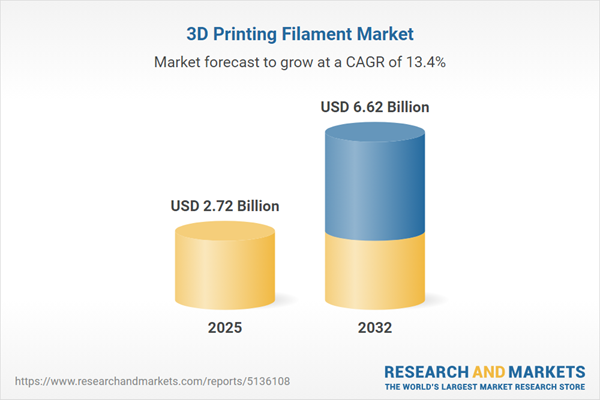Speak directly to the analyst to clarify any post sales queries you may have.
The global 3D printing filament market is evolving as industries adapt to new technologies and regulatory demands. Senior decision-makers are seeking informed strategies to boost supply chain resilience, optimize procurement, and drive compliance across complex environments.
Market Snapshot: 3D Printing Filament Market Growth and Innovation
The 3D printing filament market is charting steady expansion, with market value projected to grow from USD 2.42 billion in 2024 to USD 2.72 billion in 2025, and an anticipated reach of USD 6.62 billion by 2032. This progression, marked by a robust compound annual growth rate of 13.39%, is underpinned by rising use of advanced polymer science and an expanding range of filament types. Organizations are increasingly focused on operational agility, enhancing procurement frameworks, and aligning with strict industry standards for both prototyping and manufacturing. The market’s flexibility empowers leadership to spearhead developments in manufacturing, ensure regulatory compliance, and accelerate product cycles for improved competitiveness.
Scope & Segmentation: Strategic Overview
- Material Types: Includes composites, metals, engineering plastics, high-performance polymers, and standard thermoplastics tailored for varying regulatory, performance, and industry requirements.
- Composites: Filaments such as carbon fiber, glass fiber, ceramic, and metal-reinforced support lightweight durability and advanced thermal resistance, prioritizing needs in aerospace and automotive applications.
- Metals: Aluminum, stainless steel, titanium, and Inconel filaments serve sectors requiring resilient, precise solutions—healthcare, industrial tooling, and precision engineering achieve reliable outcomes through such offerings.
- Technologies: Fused deposition modeling, pelletization, custom extrusion, and pellet-fed systems drive scalability and flexible manufacturing. These approaches support transitions from research stages to high-volume production, enabling varied workflow customization.
- End-Use Industries: Application reaches across aerospace, automotive, electronics, healthcare, education, architecture, prototyping, tooling, art and design, jewelry, and the hobbyist segment, each demanding specialized expertise and tailored innovation.
- Distribution Channels: Sourcing is managed through distributors, specialty outlets, mass retailers, direct e-commerce by manufacturers, and B2B digital platforms, which streamline procurement and offer adaptive responses to regional needs.
- Regions: Key geographies encompass North America, Latin America, Europe, Middle East, Africa, and Asia-Pacific. Markets like the United States, Germany, China, India, Japan, and Brazil present unique regulatory and logistical considerations, underscoring the importance of regional expertise.
Key Takeaways: Strategic Insights for Decision-Makers
- Diversifying filament options positions organizations to address evolving technical standards and regulatory compliance, strengthening competitive stances in challenging environments.
- Robust digital procurement systems combined with comprehensive distribution streamline transparency, permitting faster decisions and greater synergy within sourcing and partner teams.
- Collaboration along the value chain—from raw materials to logistics—spurs innovation, optimizes risk control, and minimizes operational disruptions.
- The increasing focus on recycled and bio-based materials aligns sourcing and manufacturing with sustainability objectives, addressing tightening regulatory and client mandates.
- Customizable manufacturing workflows enable quicker adaptation to compliance changes and support tailored contractual responses for diverse industry demands.
- Broadening supplier networks and entering new regions help limit exposure to supply volatility, enhancing continuity in an evolving market landscape.
Tariff Impact: Managing Regulatory Shifts
The introduction of recent U.S. tariffs on imported polymers has prompted companies to reassess sourcing priorities, placing greater value on supply reliability over short-term cost considerations. Industry leaders are boosting recycling initiatives, exploring renewable material sources, and forming regional supplier partnerships to sustain operational stability amid regulatory flux and market uncertainties.
Methodology & Data Sources
This analysis employs a triangulated approach leveraging executive interviews, technical literature surveys, and proprietary data analytics. Such a method ensures findings support best practices in strategic planning and risk management, offering actionable intelligence to guide procurement and supply chain leadership.
Why This Report Matters
- Empowers sourcing executives to refine strategies that address supply chain complexities, meet compliance requirements, and realize cost efficiencies in rapidly shifting business contexts.
- Equips leadership with critical sourcing intelligence, tools for partnership resilience, and the agility to respond to dynamic global market movements.
- Delivers practical insights to help organizations preserve their competitive position as manufacturing standards and regulations transform.
Conclusion: Advancing Growth and Strategic Resilience
Leaders who invest in filament innovation, adaptive manufacturing, and robust supply networks are positioned to overcome change, foster growth, and sustain business resilience in the evolving 3D printing filament sector.
Additional Product Information:
- Purchase of this report includes 1 year online access with quarterly updates.
- This report can be updated on request. Please contact our Customer Experience team using the Ask a Question widget on our website.
Table of Contents
3. Executive Summary
4. Market Overview
7. Cumulative Impact of Artificial Intelligence 2025
Companies Mentioned
The companies profiled in this 3D Printing Filament market report include:- Evonik Industries AG
- 3D4Makers B.V.
- 3D HUBS B.V. by Protolabs
- 3D Systems, Inc.
- Apium Additive Technologies GmbH
- Arkema S.A.
- BASF SE
- ColorFabb B.V
- Desktop Metal Inc.
- Dream Polymers
- DuPont de Nemours, Inc.
- HATCHBOX 3D
- Henkel AG & Co. KGaA
- Hewlett-Packard Development Company, L.P.
- Intamsys Technology Co., Ltd.
- Koninklijke DSM N.V.
- Manlon Polymers
- Materialise NV
- N-Fil3D
- Shenzhen Esun Industrial Co., Ltd.
- Solvay SA
- Stratasys, Ltd.
- Ultimaker B.V.
- Victrex PLC
Table Information
| Report Attribute | Details |
|---|---|
| No. of Pages | 183 |
| Published | November 2025 |
| Forecast Period | 2025 - 2032 |
| Estimated Market Value ( USD | $ 2.72 Billion |
| Forecasted Market Value ( USD | $ 6.62 Billion |
| Compound Annual Growth Rate | 13.3% |
| Regions Covered | Global |
| No. of Companies Mentioned | 25 |









